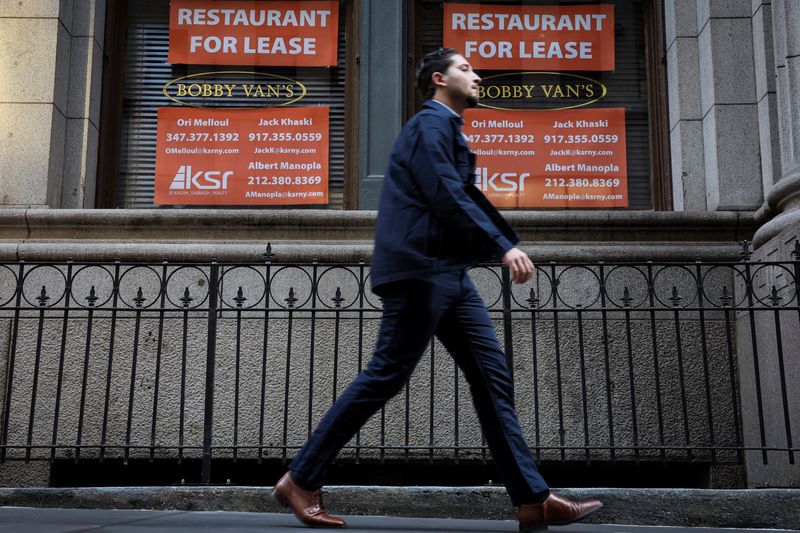US job openings fall marginally, consumers less upbeat on the labor market

By Lucia Mutikani
WASHINGTON (Reuters) – U.S. job openings fell modestly in June and data for the prior month was revised higher, suggesting the labor market continued to gradually slow and was not in danger of rapidly weakening.
Consumers’ perceptions of the labor market are, however, deteriorating. A survey from the Conference Board on Tuesday showed the share of consumers who viewed jobs as “hard-to-get” rising to the highest level in more than three years.
The proportion of those who believed jobs were “not so plentiful” was also the highest since March 2021. A rise in the unemployment rate over the past three months had stoked concerns about labor market weakness and the overall economic expansion.
Federal Reserve officials started a two-day policy meeting on Tuesday and are expected to leave the central bank’s benchmark overnight interest rate in the 5.25%-5.50% range, where it has been since last July.
“The labor market has cooled over the last several months but isn’t weak,” said Nancy Vanden Houten, U.S. lead economist at Oxford Economics. “However, that’s a scenario the Fed wants to guard against, and we expect the Fed to begin cutting rates in September.”
Job openings, a measure of labor demand, had dropped 46,000 to 8.184 million by the last day of June, the Labor Department’s Bureau of Labor Statistics said in its Job Openings and Labor Turnover Survey, or JOLTS report.
Data for May was revised higher to show 8.230 million unfilled positions instead of the previously reported 8.140 million. Economists polled by Reuters had forecast 8.0 million job openings in June.
Job openings have been steadily declining since hitting a record 12.182 million in March 2022 as demand moderates in response to the U.S. central bank’s aggressive interest rate hikes. They are down by 941,000 over the year.
There were 0.9 job openings for every unemployed person in June, down from 1.1 in May. Job openings increased 120,000 in accommodation and food services, while there were an additional 94,000 unfilled positions in state and local government, excluding education.
But there were 88,000 fewer open positions in durable goods manufacturing. Vacancies decreased 62,000 in the federal government. Job openings increased among small businesses with less than 10 employees. They, however, dropped among those with 10 to 49 workers. Medium-sized and large firms reported a decline in unfilled jobs.
The job openings rate was unchanged at 4.9%.
Stocks on Wall Street were mixed. The dollar rose against a basket of currencies. U.S. Treasury prices were little changed.
DECLINING HIRES
Hires declined 314,000 to 5.341 million. The largest drop in 16 months pushed the hires rate to 3.4%, the lowest level since April 2020, from 3.6% in May. Only businesses with fewer than 10 workers increased hiring.
Layoffs decreased 180,000 to 1.498 million, the lowest reading since November 2022. The labor market slowdown is being driven by reduced hiring rather than layoffs. A loosening labor market adds to subsiding inflation in building the case for a September rate cut. The Fed has hiked its policy rate by 525 basis points since March 2022 to tame inflation.
“June JOLTS estimates continue to point to a stabilization of labor demand in recent months, suggesting, for now, that the labor market is in a ‘sweet spot’ where demand and supply are well balanced” said Jonathan Millar, an economist at Barclays.
Hiring declined 115,000 in professional and business services and dropped 111,000 in accommodation and food services. It decreased 41,000 in construction. Layoffs were down in nearly all industries, with the exception of retail trade, where they rose 25,000. The layoffs rate dropped to 0.9% from 1.1% in May.
The number of people voluntarily quitting their jobs dropped 121,000 to 3.282 million. Quits fell 64,000 in construction.
The quits rates, viewed as a measure of labor market confidence, was unchanged at 2.1%. A steady quits rates bodes well for subsiding wage pressures and overall inflation.
The lull in resignations was best captured by the Conference Board survey, which showed the share of consumers who reported that jobs were “not so plentiful” rose to 49.9% this month, the highest level since March 2021, from 48.8% in June.
The proportion that viewed jobs as “hard-to-get” increased to 16.0%. That was also the highest reading since March 2021 and was up from 15.7 in June.
The survey’s so-called labor market differential, derived from data on respondents’ views on whether jobs are plentiful or hard to get narrowed to 18.1 from 19.8 in June.
This measure correlates to the unemployment rate in the Labor Department’s monthly employment report. The unemployment rate rose to a 2-1/2-year high of 4.1% in June.
While consumer confidence increased this month from June’s revised level, buying intentions over the next six months fell across the board. The share of consumers planning to buy a house was the lowest since February 2013.
That suggests a strong housing market rebound is unlikely even as mortgage rates have retreated after surging in spring and house price inflation is slowing.

A third report from the Federal Housing Finance Agency showed house prices increased 5.7% year-on-year in May, the smallest gain in 10 months after rising 6.5% in April.
“It will take until 2025, or even 2026, for the market to become better balanced,” said Thomas Ryan, North America economist at Capital Economics.





